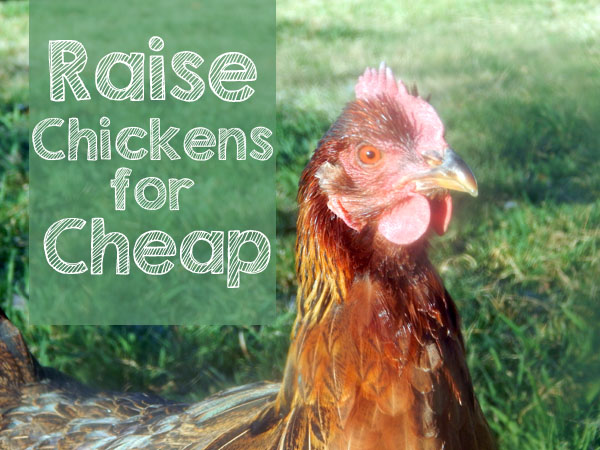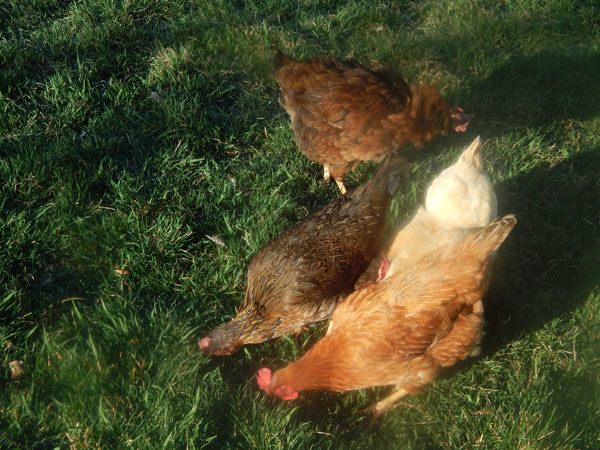A few years ago, we jumped into the whole suburban chicken farming movement But it took me a while for me to commit. . (I have a philosophy of not bringing any creature into our place unless I’m prepared to deal with their poop.)
One of the reasons why I dragged my feet on getting chickens is because I was afraid of the start-up costs.
When I first started investigating raising chickens, I calculated my first-year costs for four chickens, including feed, housing, and other essentials. The total was $804. For the year, that would work out to $32 a dozen for eggs.
Ouch.
Fortunately, I was able to reduce my costs significantly. Here’s how you can do it too:
1. Build a chicken coop
A coop will be your biggest upfront cost. Even if you free-range your chickens, you really need a chicken coop to protect your birds from weather and predators. Pre-built chicken coops can cost $400 and up. You can save some money and order a pre-fab chicken coop to assemble yourself for half that cost. But you can save even more by building the coop on your own. Just Google free chicken coop plans to find a plan that works for you. Even with new wood, the costs for a new coop can be just 50 dollars. Use pallet wood or reclaimed wood to bring the cost down even lower.
But does building a coop from scratch (no pun intended) intimidate you? Then you should try:
2. Hack an existing structure into a coop
We built our chickens’ run (the outside pen that chickens run around in) However, we didn’t feel like we could tackle a coop. Fortunately, we knew someone who had decided to stop raising chickens, and they gifted us their old coop ($0). If you’re not so lucky to get a free coop, try to modify an existing structure into a chicken coop.
Chickens only need a few things in their coop:
- Basic shelter
- A place to roost
- A nest box
Because of this, you can modify all sorts of items to create a coop. You can:
- Reclaim an old shed that’s falling apart
- Turn an old plastic sandbox into a coop
- Convert one of those big 90’s TV entertainment centers
- Use an old swing set for the frame of a new coop
- Turn an old plastic playhouse into a coop
- Or a trampoline
Look on freecycle.org for cast off items that you can repurpose into a coop.
3. Start with pullets
What are pullets? Well, you can think of pullets as chicken teenagers. Like teenagers, they are not as cute as babies and they are more expensive. Around here, you can get baby chicks for $1 and pullets for $3-$4.
So why do I recommend pullets over chicks? For two reasons:
- Baby chicks are delicate. They require extra care, a brooder (which costs), and special feed. You can’t turn them loose outside. They take a lot more effort. Plus, the mortality rate is a lot higher for baby chicks. I would hate to explain to my kids how that cute little chick died without warning under their care.
- It’s easier for the chicken farmers to tell gender on a pullet than a chick. When you get your chickens as chicks, there’s a 50% chance you’re raising a rooster than a hen. On pullets, you are 75% likely to get a hen. More on that importance later.
4. Use cheap bedding alternatives
At the feed store, they’ll sell you a big pack of pine shavings to put in the nesting box for the chickens to sit in, as well as the floor of the coop. It’s the same stuff that you use for lining hamsters’ cages. Unlike hamsters with their little pellets of poop, chickens poop a lot. And it’s messy, so you’ll be changing bedding often. That big bag of pine shavings will dwindle pretty quickly. However, you can supplement the bedding with cheaper alternatives. You can use:
- straw (if you can get it for cheap)
- dry pine needles
- shredded dead leaves
- mown grass (make sure that the grass is nice and dried out. Green grass will clump and smell)
- shredded paper and cardboard (even your kids’ old papers!)
5. Feed chickens table scraps
A bag of feed will last my little flock of four birds one month if that is their only food source. However, chickens love variety, and will eat lots of things that you have designated for the compost pile. Some of the things my chickens love:
- leftover cooked rice and pasta
- stale bread
- cabbage cores
- the wilted outer leaves of lettuce
- broccoli and cauliflower leaves
- vegetable peels, like carrots and cucumbers
- celery tops
- apple and pear cores
- watermelon and cantaloupe rinds
- leftover popcorn (including the unpopped kernels)
- weevil-infested grain
- and on and on. . . .
It’s easier to list what they shouldn’t eat. They’ll even eat eggs and chicken (shudder) but I avoid that. You should also avoid feeding them:
- onions
- potato and potato peels
- avocados
- raw meat
- spoiled food
You shouldn’t just feed your chickens table scraps. They do need store-bought feed. However, supplementing their feed really helps stretch the food budget.
6. Let the chickens loose
In addition to feeding your flock table scraps, you should let them roam around your yard and scavenge. Chickens love bugs and finding their own green stuff.
By feeding my flock table scraps and letting them free-range, I can stretch a bag of feed to last two to three months.
7. Have an end plan
Chickens only lay eggs for four to five years. But they can live for 20 years. If you get chickens for eggs, you need to plan for the time that they stop laying.
Don’t plan on giving them away. Our Humane Society is swamped with old hens. . .a sad byproduct of overeager suburban chicken farmers who didn’t think ahead. I know of one person who lets his old hens out in a state park. . to go “back to nature.” That’s a terrible idea! Not only is it illegal, but it’s cruel to the chicken. How do you think the chicken will fend for herself in the wild when she’s been raised depending on you for food and shelter?
It’s a hard thing, but you have to be prepared to take the ax to your chicken when it’s time. Or else you will have feathered pets for a long time.
And you may have to do it sooner than you realize. Remember how I mentioned that you should have your chickens sexed beforehand? It’s not an exact science to determine whether you have a girl or a boy bird. You may end up with a rooster.
Many municipalities don’t allow roosters, and I don’t blame them. Growing up in Southern California, we had neighbors who had a rooster. That %$^# thing crowed at all our hours, not just at the crack of dawn.
So when we got our chickens, we started noticing that one of our chickens, Roadrunner, was looking a little masculine. She started getting thicker feet and comb, and she started bossing the other chickens around. We kept thinking that it was because she was the head of the flock. Then one morning, she hopped up and gave us her best crow. We couldn’t deny it any longer. We had to dispatch him.
Not a fun experience, but it had to be done. I now know that I couldn’t raise chickens for meat, and I’m not looking forward to getting rid of the rest of my flock. But it’s a reality when you raise chickens.
_____________
Unlike vegetable gardening, the cost benefits of raising chickens for eggs are not so cut-and-dried. You are not going to beat grocery store prices of $1.19 a dozen. But if you want organic and free-range eggs, raising your own eggs actually may save you money. Plus, you get the benefits of all that free chicken manure for your garden and lawn.
And there are those intangible benefits, such as teaching your children where their food comes from. When you raise chickens for eggs, those chickens have a far better life than factory birds–even free-range factory birds. It’s something that I’ve tried to strive for, especially after reading Animal, Vegetable, Miracle: A Year of Food Life by Barbara Kingsolver.
Lastly, chickens are just fun. Each chicken has her own little personality. Isabelle loves to tell us when she’s laid an egg. Tyrone jumps up onto everything, including my head. Salt and Pepper are the first ones to come running when I scatter grain.
It may cost us a little more per egg, but for our family, it’s worth it.
What are your experiences with raising chickens?
Note: This post contains affiliate links. If you purchase something through these links, I get a little extra and it’s no additional cost to you.
I’ve shared this link on:
- Works for Me Wednesdays at Giving Up on Perfect
- Penny Pinching Party at The Thrifty Home
- Thrifty Thursday at Living Well Spending Less
- Frugal Fridays at Sarah Titus
- The Handmade Hangout at Too Much Time on My Hands
- Link Party Palooza at tatertots & jello




Just the post on chickens I was looking for! Pinning & sharing!
Lisa/Syncopated Mama recently posted…Project Snapshot Week 64
Thanks Lisa! You’ll have to let us know how your adventure in chickens goes!
What a great post! As a chicken owner of many years…I learned a few things! Thanks for taking the time to help us save some money!
Janelle@The Peaceful Haven recently posted…Creamy Delicious Gluten Free Guacamole
I’m so glad Janelle! I love my chickens, but it’s not a big money saver. Anything we can do to make it cheaper is okay by me.